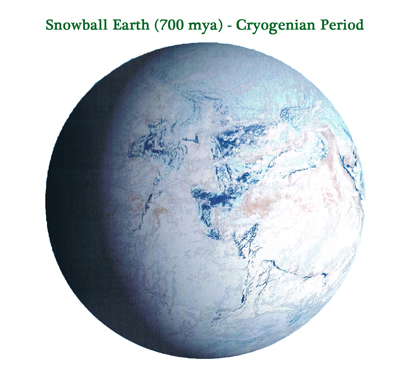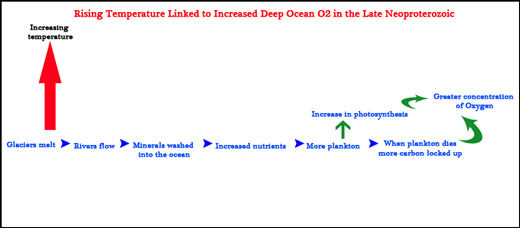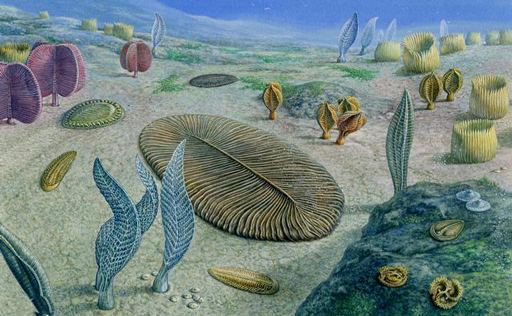Selenium Isotope Analysis Supports Idea of Progressive Oxidation
Most complex life on Earth, that is organisms that have evolved beyond the unicellular stage, depend on oxygen. Fundamentally without O2, life on our planet would be very different, for one thing this highly reactive element is needed before amino acids and hence proteins can form. Every breath you take reinforces the importance of oxygen to our planet’s great diversity and variation of life. However, when did the oxygenation of our planet begin and how quickly did oxygen build up on Earth to allow complex life forms and more complicated ecosystems to evolve?
Earth Seven Hundred Million Years Ago – A Frozen Planet

“Snowball Earth” – progressive oxidation.
Picture credit: Everything Dinosaur
A new study published in the academic journal “Nature Communications” carried out by a team of international scientists, including researchers from University College London, Leeds University and the University of Washington, suggests that it took around 100 million years for oxygen levels in the atmosphere and oceans to rise to a level that allowed a rapid increase in the diversity and variety of life on Earth.
This research, that involved analysing selenium isotope concentrations from seven different locations, indicates that there was not a steady and sustained rise in O2 levels over this period, oxygen concentrations fluctuated, the amount of O2 increased in fits and starts leading to a substantial increase in life around 600 million years ago.
Which Came First More Animals or More Oxygen?
One of the fundamental questions that the scientists sought an answer to in this Natural Environment Research Council funded project was this – did rising oxygen levels permit the explosion of animal life recorded in the fossil record from about 600 million years onwards or was it a change in animal evolution that kick-started the rise of oxygen?
In simple terms:
- Did rising O2 levels lead to an expansion in complex animal life?
OR
- Did an expansion of more complex animal forms give rise to greater levels of oxygen?
This research suggests that the rise of O2 began significantly earlier than previously thought and the increase of oxygen was not a linear one, O2 levels rose, stalled and rose again over a vast period of geological time (at least 100 million years). If the conclusions reached by the scientists are correct, then it is likely that early animal evolution was kick-started by an increase in the amount of oxygen available, rather than a change in animal behaviour leading to greater levels of O2 in the atmosphere and oceans.
Explaining the purpose of the isotope study, lead researcher Dr Philip Pogge von Strandmann (University College London) stated:
“We want to find out how the evolution of life links to the evolution of our climate. The question on how strongly life has actively modified Earth’s climate, and why the Earth has been habitable for so long is extremely important for understanding both the climate system, and why life is on Earth in the first place.”
Starting at the Bottom – Marine Shales Actually…
To gain a better understanding of Earth’s climate during the Neoproterozoic (that vast era of geological time from about a billion years ago to 542 million years ago), the international team of scientists analysed selenium isotope data retrieved from samples of marine shales laid down at the bottom of the sea at different times from seven different locations to piece together a global picture of oxygen levels in the oceans and the atmosphere.
Strata studied included rocks across the United States, China and Canada and this work was conducted with the collaboration of Utah State University, Birkbeck (London) and Bristol University along with scientists from the University of Southern Denmark.
Selenium Isotopes
Selenium isotopes from marine shales can act as a indicator of global oxygenation conditions. Lighter Se (selenium) isotopes recorded in shales generally indicate more oxygen rich conditions. So by measuring the different selenium isotope ratios recorded in rocks of different ages, the scientists can start to build up a picture of the amount of O2 on the planet, specifically the level of oxygen in deep water, which in turn reflects on the amount of oxygen likely to exist elsewhere on the planet such as near to the coasts and in the atmosphere.
The selenium isotope analysis revealed that it took over 100 million years for the amount of oxygen in the atmosphere to climb from less than 1% to over 10% of today’s current level (20.8%).
Dr Pogge von Strandmann said:
“We took a new approach by using selenium isotope tracers to analyse marine shales which gave us more information about the gradual changes in oxygen levels than is possible using the more conventional techniques used previously. We were surprised to see how long it took Earth to produce oxygen and our findings dispel theories that it was a quick process caused by a change in animal behaviour.”
Specifically the researchers focused on looking at strata laid down during the Cryogenian (720-635 million years ago) and Ediacaran (635-542 million years ago), towards the end of the Neoproterozoic.
During the period studied, three big glaciations –the “Snowball Earth” Sturtian (about 716 million years ago), and the Marinoan (635 million years ago) glaciations and the smaller Gaskiers glaciation (about 580 million years ago) occurred in which much of the planet (if not all of it), was covered in ice with the seas frozen and glaciers dominating the land.
As temperatures dropped, so the conditions for life that did exist at the time became extremely harsh. However, when the temperature of the Earth rose, the glaciers melted and released vast quantities of mineral nutrients into the oceans. The research team hypothesise that the ice melt and increased nutrient mix in the sea helped cause oxygen levels to rise in the deep ocean.
Glaciation and Subsequent Melt Boosted Oxygen Levels

Increased oxygen due to glacier melt.
Picture credit: Everything Dinosaur
Increased nutrients in a marine environment leads to more ocean plankton, which will bury and trap organic carbon in sediments at the bottom of the sea when they die. Burying carbon results in oxygen increasing, dramatically changing conditions on our planet. Up until this paper was published, oxygenation was thought to have occurred after the relatively small Gaskiers glaciation melted in the middle of the Ediacaran.
The findings from this study suggests that oxygenation occurred much earlier, linking a rise in O2 levels to the Marinoan glaciation, after which animals began to flourish in the improved conditions. As life flourished so more and more diversity came about. This led to the Cambrian explosion, a burst of evolution that began around 542 million years ago.
Everything Dinosaur stocks a range of models of Palaeozoic creatures such as trilobites, horseshoe crabs and cephalopods: CollectA Prehistoric World Models.
Oxygen a Slow Fuse
Professor David Catling (University of Washington), a co-author of the scientific paper stated:
“Oxygen was like a slow fuse to the explosion of animal life. Around 635 million years ago, enough oxygen probably existed to support tiny sponges. Then, after 580 million years ago, strange creatures, as thin as crêpes, lived on a lightly oxygenated floor of the sea. Fifty million years later, vertebrate ancestors were gliding through oxygen-rich seawater. Tracking how oxygen increased is the first step towards understanding why it took so long. Ultimately, a grasp of geologic controls on oxygen levels can help us understand whether animal-like life might exist or not on Earth-like planets elsewhere.”
Oxygen and the Slow Fuse to More Diverse Complex Life

Life in the Ediacaran.
Picture credit: John Sibbick
Related Articles
To read an article (2012), that looks at some of the world’s oldest fossils: Are these the oldest fossils known?
Research (2014), suggests that multicellular life began earlier than previously thought: New research suggests multicellular life started earlier.
From August 2015, an article covering details of a study into ancient animal reproduction: Earliest evidence of reproduction in a complex organism.




